Recent Articles
Popular Makes
Body Types
2021 Hyundai Santa Fe HEV Road Test and Review
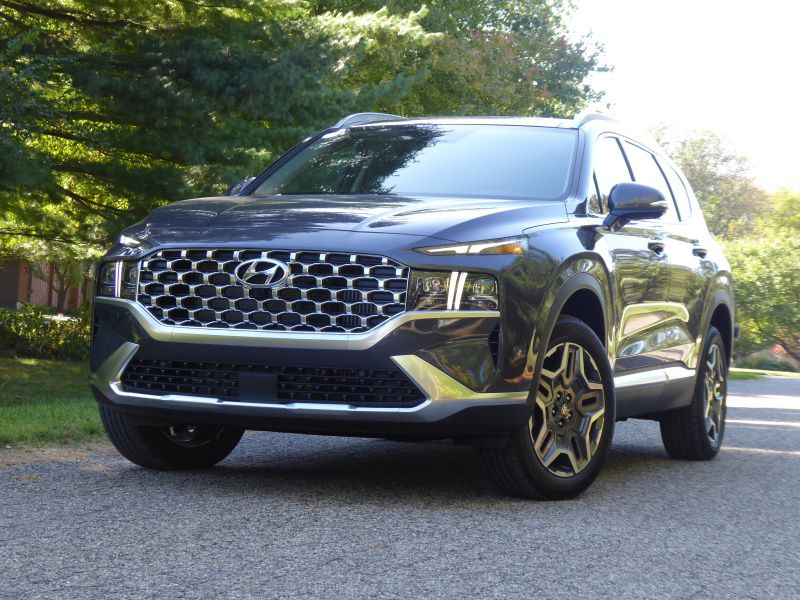
2021 Hyundai Santa Fe Hybrid ・ Photo by Ron Sessions
Joining the growing ranks of gas-electric hybrids this year is the 2021 Hyundai Santa Fe Hybrid. The hybrid version of the 5-passenger, mid-size SUV is part of a major electrification roll-out at Hyundai that also includes hybrid iterations of the 2022 Tucson, 2021 Elantra, Sonata, and Ioniq Hybrids, as well as the battery electric 2021 Kona and Ioniq. A plug-in version of the Santa Fe Hybrid will also join the lineup later this summer.
Including the $1,185 destination charge, 2021 Santa Fe Hybrid prices are $34,835 for the base Blue model, $38,785 for the well-equipped SEL, and $41,135 for the top-of-the-line Limited. All-wheel drive is standard with Santa Fe Hybrid models.
Pricing and the standard-equipment breakdown for the upcoming plug-in version of the Santa Fe Hybrid have not yet been announced. The plug-in hybrid will be available in just two trims: SEL and Limited.
The Santa Fe’s hybrid competitors include the mid-size Toyota Venza and Kia Sorento, plus the compact Toyota RAV4, Honda CR-V, and Ford Escape. Competitors to the upcoming plug-in version of the Santa Fe Hybrid include the RAV4 Prime, Ford Escape, Mitsubishi Outlander, and Subaru Crosstrek.
Hybrid Power
The new Santa Fe Hybrid is equipped with a powertrain that’s different from that of most competitors. Internal combustion is provided by a turbocharged 1.6-liter 4-cylinder that’s rated at 177 horsepower and 195 lb-ft of torque. It works in conjunction with a 60-hp electric traction motor for an overall system output of 226 hp. But instead of the usual continuously variable transmission used widely elsewhere that can give a disconnected feel and sound to the engine, the Santa Fe Hybrid uses a conventional 6-speed step-shift transmission. Except for the smooth electric-motor feel launching from a stop, the Santa Fe Hybrid feels more like a conventional gas model as it accelerates up through the gears, albeit one with extra power and instant torque courtesy of the electric motor boost.
EPA estimates for the new Santa Fe Hybrid AWD are 32 mpg to 34 mpg in combined city/highway driving. That’s 8 mpg to 10 mpg more thrifty than the mileage estimates for Santa Fe’s 2.5-liter conventionally powered AWD versions.
In an afternoon driving 64 miles over suburban residential streets and 55-mph rural 2-lane highways, the all-wheel-drive Santa Fe Limited Hybrid displayed an average 34.2 mpg on the trip computer.
A plug-in Santa Fe Hybrid with the same 1.6-liter gas turbo, but a 90-hp electric motor and 260-hp combined output will debut this summer. It will feature 30 miles of all-electric range with 76 MPGe and 33-mpg combined city/highway EPA mileage estimates.
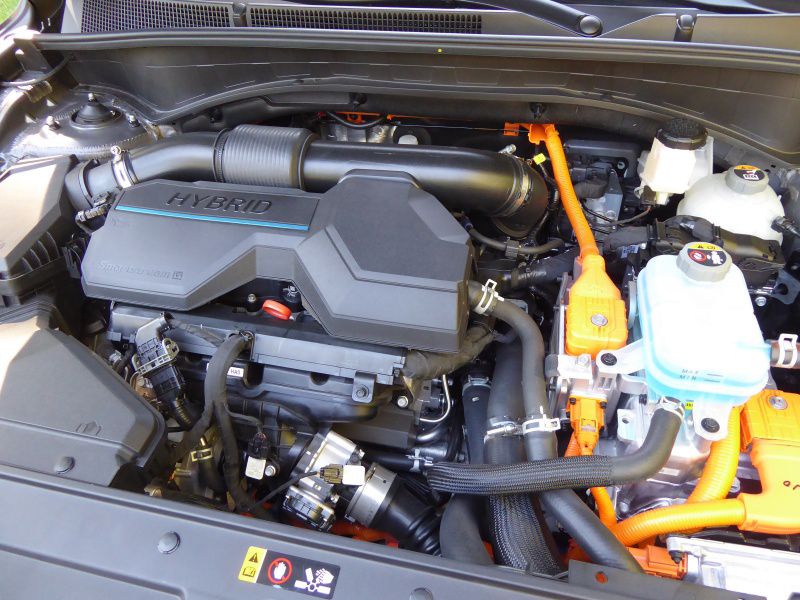
Photo by Ron Sessions
Roomy, Upscale Interior
Open a door and the new Santa Fe Hybrid offers a hushed interior with an elegant, Palisade-inspired high-mounted center console with added storage underneath. Atop the console, a new pushbutton shifter replaces last year’s conventional shift lever. The luxurious interior is awash in soft-touch, high-quality materials. A new 12.3-inch full-color digital instrument cluster that changes its appearance with different drive modes is standard with all Hybrid trims.
The Blue trim gets stain-resistant cloth seat coverings, heated front seats, a power driver’s seat with 2-way lumbar support, pushbutton start, a proximity key, set-and-forget dual-zone automatic climate control, and a tilt and telescoping leather-wrapped steering wheel. The dual-zone system even has a setting to direct all fan output to the driver, rather than trying to heat or cool the entire cabin. Also standard is a slot-type wireless charger for Qi-enabled phones, plus 12-volt and dual 2.1-amp USB charge ports.
SEL trim brings leather seat coverings, a power front passenger seat, a panoramic sunroof, and LED interior lighting.
Limited upgrades to ventilated front seats, a heated steering wheel, a woven, multi-fabric headliner, rain-sensing wipers, a 115-volt power point, and a driver’s seat with memory settings, a power leg cushion extension, and 4-way lumbar adjustment.
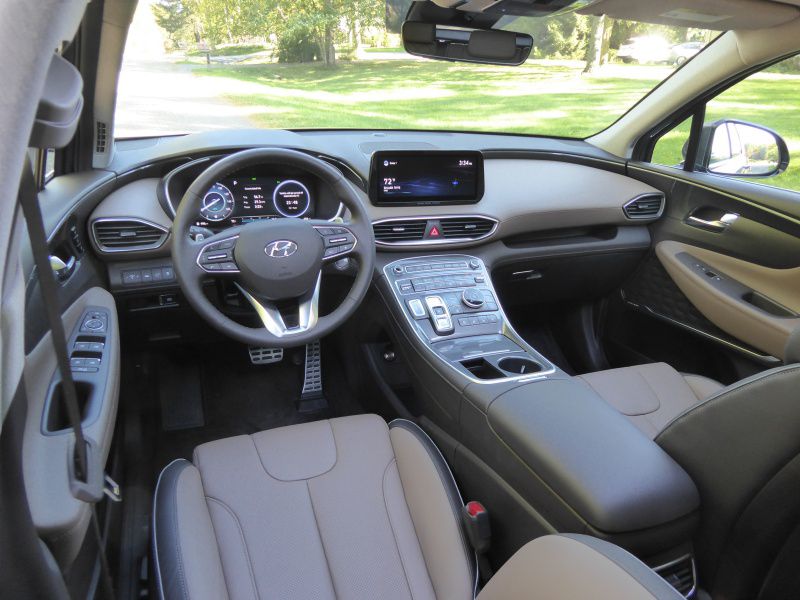
Photo by Ron Sessions
Standard HTRAC All-Wheel Drive
Hyundai’s HTRAC all-wheel drive system is standard with all Hybrid trims. There are four selectable driving modes, accessed via a rotating knob on the center console. Smart mode provides stable driving dynamics for everyday driving, and it varies front-to-rear torque distribution from 80% front/20% rear to 65% front/35% rear. Sport mode ups the fun factor with higher revs, delayed upshifts, and sportier handling as it varies torque distribution between 50% front/50% rear and 65% front/35% rear. Eco mode reduces acceleration response and prioritizes fuel economy, varying the front/rear torque split from 100% front/0% rear to 80% front/20% rear. Snow mode optimizes the system for low traction situations.
The AWD differential lock button in the center of the rotating knob is for tackling steep hills or off-road situations. When pushed below 37 mph, it locks the torque split evenly at 50/50. Above 37 mph, pressing the button puts HTRAC in AWD Auto mode.
Side-to-side torque vectoring is provided by traction-control system braking.
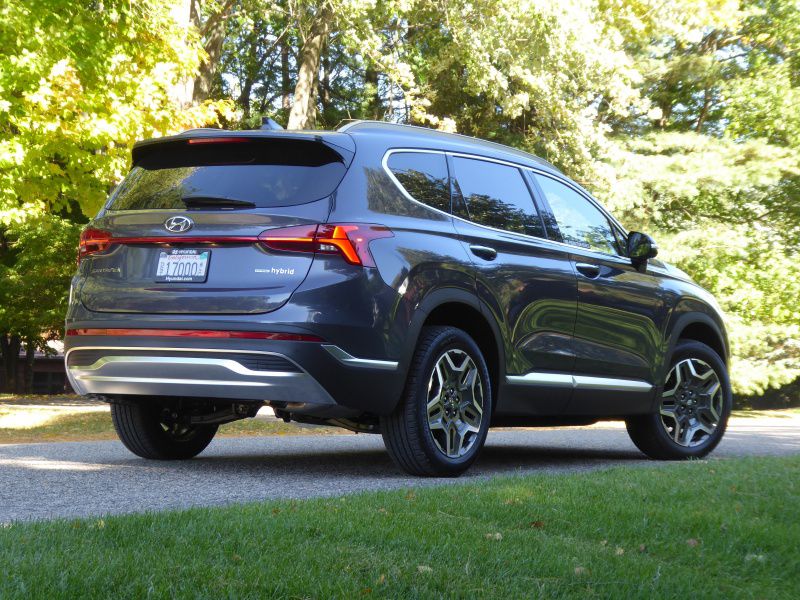
Photo by Ron Sessions
Infotainment Systems
In the base Blue trim, the new Santa Fe Hybrid comes standard with an 8-inch infotainment screen featuring wireless Apple CarPlay and Android Auto, reducing the tangle of USB cables and allowing a smartphone to be put away in the glovebox, a purse, or a computer case where it won’t present a driving distraction. The basic setup includes an AM/FM stereo, a 3-month trial of SiriusXM, HD Radio, and voice recognition for access to phone, maps, messages, music, and third-party apps, as well as Blue Link connected-car services.
Limited trim upgrades to a wide-screen, high-resolution 10.25-inch touchscreen with embedded navigation. It features split-screen capability for maps and music, junction-view lane guidance, and access to vehicle and driver-assist settings, plus HD Radio traffic-flow and incident data. It includes a rich-sounding, premium 12-speaker Harman Kardon surround-sound system with and Clari-Fi music restoration technology. Apple CarPlay and Android Auto are onboard as well, but with the larger screen, they revert to a wired system that requires a USB connection.
The 10.25-inch system also includes dynamic voice recognition. This is a more advanced technology that allows the use of common speech to perform a wide variety of requests, such as adjusting the climate control, doing a point-of-interest search for destinations, and much more.
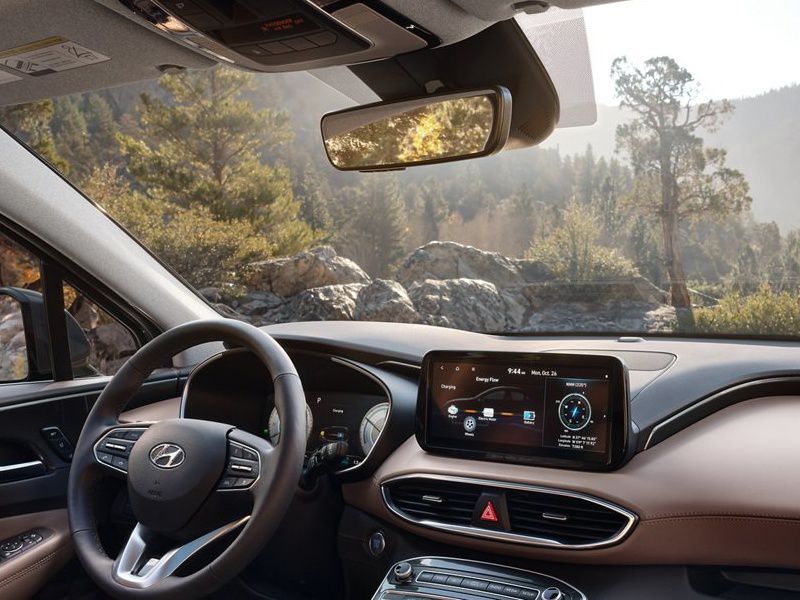
Photo by Hyundai
Connected Services
Complimentary for the first three years of ownership, Hyundai includes Blue Link connected services on all Santa Fe Hybrid models. Capabilities include remote door locking and unlocking, remote engine starting, adjustable climate control settings, seats, and mirror positions, and more. Access is through the Blue Link smartphone app, the MyHyundai web portal, the Blue Link Google Assistant app, and the Amazon Alexa Blue Link skill, as well as some Apple and Android smart watch apps.
Also standard with Santa Fe Hybrids is Hyundai’s digital key technology. Although it doesn’t currently work with iPhones, it converts the owner’s Android smartphone into a vehicle remote for functions such as door locking and unlocking and engine starting. It even works with the Android phones of friends and family; once access is enabled, the owner is able to control what functions are available and for how long. Digital Key uses Near Field Communications (NFC) technology, which works only within a few feet of the vehicle.
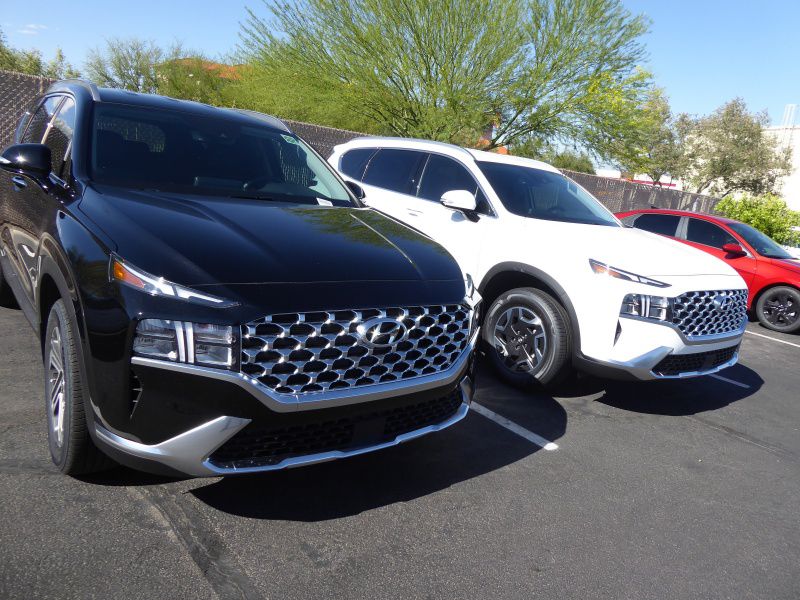
Photo by Ron Sessions
Spacious Back Seat
The Santa Fe Hybrid has an adult-friendly back seat with generous headroom and legroom. The rear seat is split 60/40, has individually reclining seatbacks, and slides fore and aft to accommodate differing rear passenger and cargo needs. When no passenger is seated in the middle, a center armrest with two cup holders folds down. Rear passengers get their own floor vents, USB power ports, and manual pull-up side window shades. Darkened privacy glass is fitted to the rear doors and cargo area.
While the Hybrid version of the Santa Fe has almost an inch less rear-seat legroom than the gas-only versions, the two-row mid-size Santa Fe Hybrid still has more legroom than a Honda Passport, Chevrolet Blazer, Nissan Murano, and even the big Volkswagen Atlas Cross Sport.
The Limited trim adds heated outboard rear-seat cushions.
Two new technologies protect rear seat occupants. Safe Exit Assist lets them know when it’s safe to open a door on the traffic side. Rear Occupant Alert uses an ultrasonic sensor to check for movement in the back seat, like a child or pet left behind, after the vehicle is parked and locked and alerts the driver.
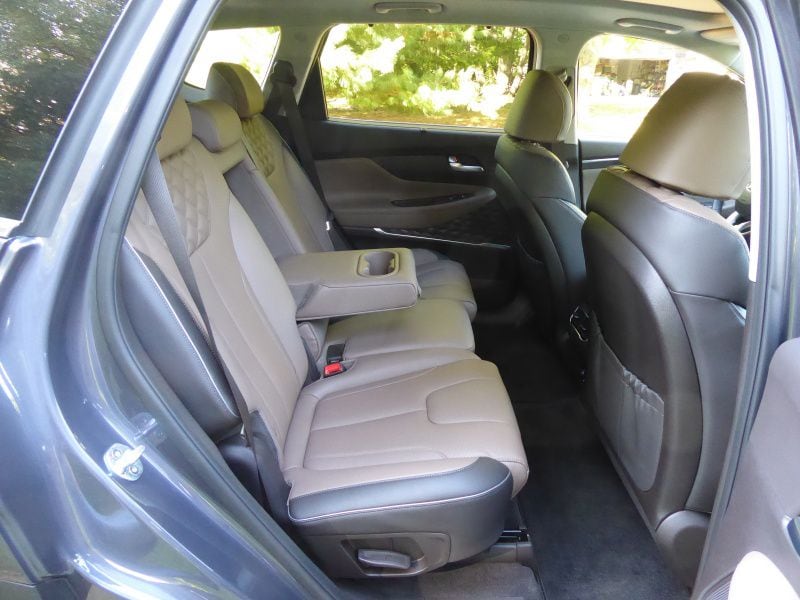
Photo by Ron Sessions
Max Cargo
The Santa Fe Hybrid’s large underfloor lithium-ion battery that provides power for the SUVs electric traction motor takes up no cargo space. So, hybrid versions of the Santa Fe offer the same generous cargo room as the gas-powered iterations. That means there's 36.4 cubic feet behind the raised rear seat, which is sufficient space for at least five airport roller bags. A power-release button inside the cargo opening drops the 60/40 split rear seat into the folded position, increasing the available cargo space to a generous 72.1 cu. ft. That’s ample room to stow a mountain bike or two.
Under the cargo floor, there's a spare tire (not just a tire repair kit as in some other hybrid SUVs) and a tray and large hidden compartment where you can stash valuables such as a purse, laptop, or camera.
Standard with all Santa Fe Hybrid trims is a hands-free power liftgate. The operating speed of the liftgate is adjustable from a standard 6 seconds to an express 4.5 seconds.
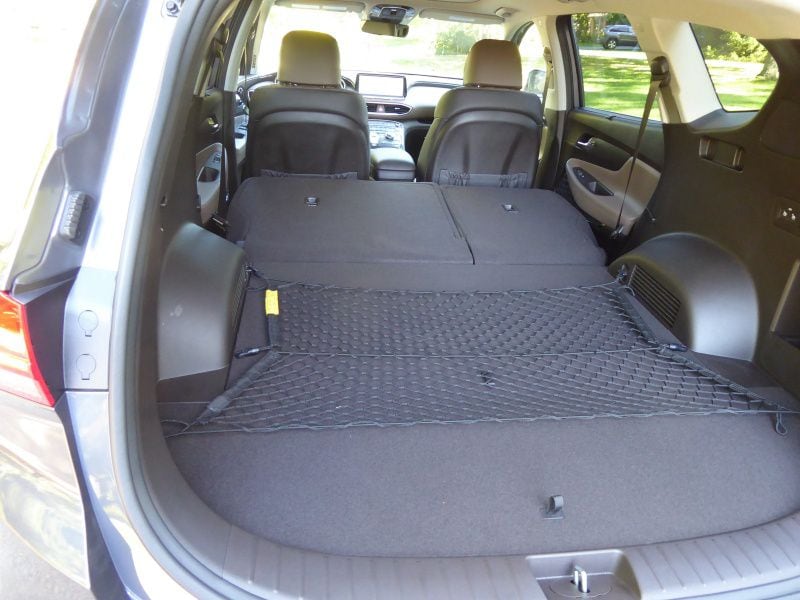
Photo by Ron Sessions
Safety and Driver-Assistive Tech
Standard Hyundai SmartSense systems on all Santa Fe Hybrid trims include forward collision warning with pedestrian, cyclist, and junction-turning detection, forward auto emergency braking, lane-departure warning, lane-keeping assist, lane-centering assist, a driver attention warning system, adaptive cruise control with full stop and go, reverse park distance warning, and automatic high-beam assistance.
Also standard with the Santa Fe Hybrid are blind-spot and rear cross-traffic collision avoidance systems. These go beyond the systems in many competitors SUVs that just monitor and warn the driver of vehicles or pedestrians in the blind-spot and rear cross-traffic areas, and will apply the brakes if the driver doesn’t to avoid a collision.
The SEL Hybrid trim adds Highway Driving Assist, which combines lane centering and adaptive cruise control to reduce stress on well-marked highways.
The Limited Hybrid trim brings a blind spot view monitor that provides a live view of the road immediately adjacent to the vehicle’s blind spot when the turn signal for that side is actuated. Also on the Limited, a surround-view camera provides an overhead view of the Santa Fe and its immediate surroundings, while a front park distance warning beeps more intensely as the Santa Fe gets closer to an obstacle when parking.
Finally, the Limited trim includes Remote Smart Park Assist, which helps the driver park the Santa Fe in tight spaces from outside the vehicle, using buttons on the smart key fob.
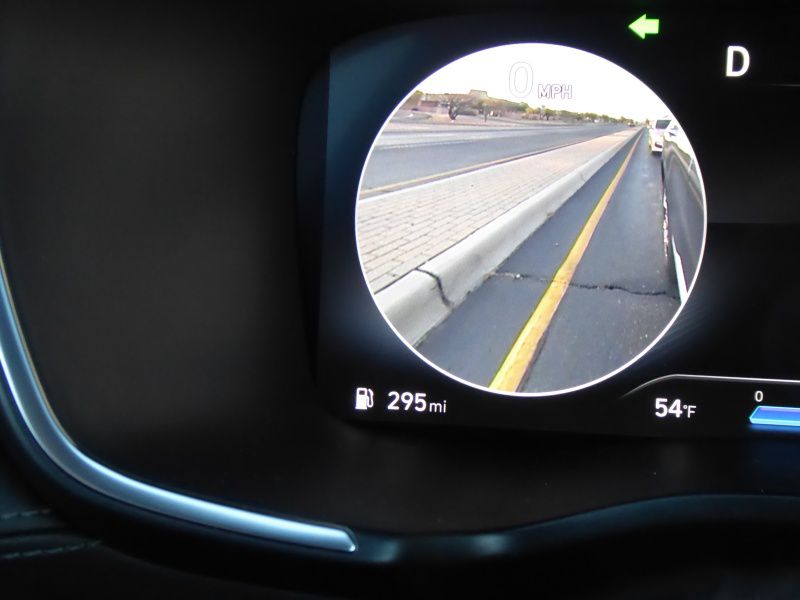
Photo by Ron Sessions
Luxurious, Smart, and Thrifty
With upscale design cues inside and out from the hot-selling three-row Palisade, the revamped 2021 Hyundai Santa Fe gets an all-new gas-electric hybrid version that adds impressive fuel economy to its long list of up-to-date product features. The roomy and luxurious Santa Fe Hybrid rolls with the latest in Hyundai’s infotainment and driver-assistive tech and presents a good value for families on a budget in the five-passenger mid-size SUV space.
Hyundai’s warranty coverage is another selling point. The company’s bumper-to-bumper warranty covers 5 years/60,000 miles, and the hybrid system powertrain warranty is best-in-class, covering 10 years/100,000 miles.
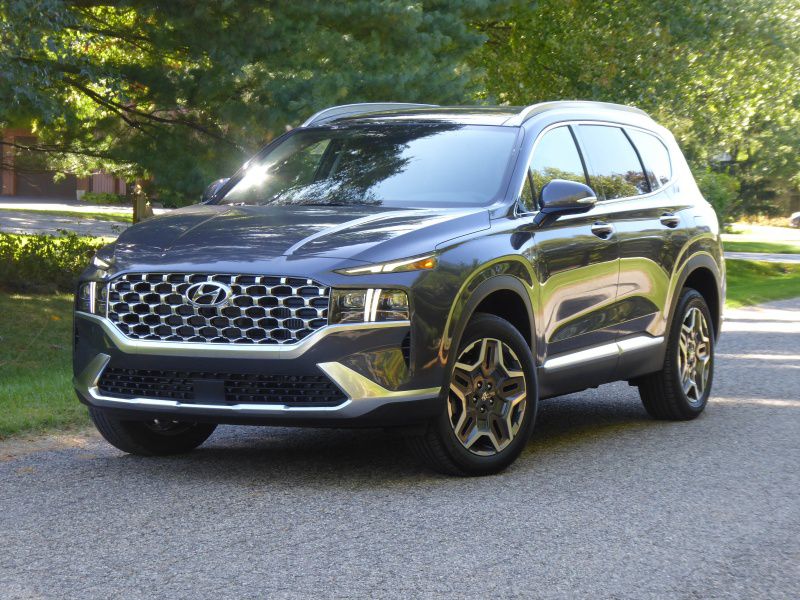
Photo by Ron Sessions